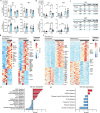Microglia in the aged brain develop a hypoactive molecular phenotype after surgery
- PMID: 39696348
- PMCID: PMC11658347
- DOI: 10.1186/s12974-024-03307-0
Microglia in the aged brain develop a hypoactive molecular phenotype after surgery
Abstract
Background: Microglia, the resident immune cells of the brain, play a crucial role in maintaining homeostasis in the central nervous system (CNS). However, they can also contribute to neurodegeneration through their pro-inflammatory properties and phagocytic functions. Acute post-operative cognitive deficits have been associated with inflammation, and microglia have been implicated primarily based on morphological changes. We investigated the impact of surgery on the microglial transcriptome to test the hypothesis that surgery produces an age-dependent pro-inflammatory phenotype in these cells.
Methods: Three-to-five and 20-to-22-month-old C57BL/6 mice were anesthetized with isoflurane for an abdominal laparotomy, followed by sacrifice either 6 or 48 h post-surgery. Age-matched controls were exposed to carrier gas. Cytokine concentrations in plasma and brain tissue were evaluated using enzyme-linked immunosorbent assays (ELISA). Iba1+ cell density and morphology were determined by immunohistochemistry. Microglia from both surgically treated mice and age-matched controls were isolated by a well-established fluorescence-activated cell sorting (FACS) protocol. The microglial transcriptome was then analyzed using quantitative polymerase chain reaction (qPCR) and RNA sequencing (RNAseq).
Results: Surgery induced an elevation in plasma cytokines in both age groups. Notably, increased CCL2 was observed in the brain post-surgery, with a greater change in old compared to young mice. Age, rather than the surgical procedure, increased Iba1 immunoreactivity and the number of Iba1+ cells in the hippocampus. Both qPCR and RNAseq analysis demonstrated suppression of neuroinflammation at 6 h after surgery in microglia isolated from aged mice. A comparative analysis of differentially expressed genes (DEGs) with previously published neurodegenerative microglia phenotype (MGnD), also referred to disease-associated microglia (DAM), revealed that surgery upregulates genes typically downregulated in the context of neurodegenerative diseases. These surgery-induced changes resolved by 48 h post-surgery and only a few DEGs were detected at that time point, indicating that the hypoactive phenotype of microglia is transient.
Conclusions: While anesthesia and surgery induce pro-inflammatory changes in the plasma and brain of mice, microglia adopt a homeostatic molecular phenotype following surgery. This effect seems to be more pronounced in aged mice and is transient. These results challenge the prevailing assumption that surgery activates microglia in the aged brain.
Keywords: Aging; Microglia; Neuroinflammation; Surgery.
© 2024. The Author(s).
Conflict of interest statement
Declarations. Ethics approval and consent to participate: The animal use procedures described in this paper were designed according to guidelines provided by the Brigham and Women’s Hospital Center for Comparative Medicine and approved by the Institutional Animal Care and Use Committee at Brigham and Women’s Hospital. Consent for publication: Not applicable. Competing interests: OB: collaboration with GSK, Regulus Therapeutics. Research funding from Sanofi, GSK, honoraria for lectures, consultancy: UCB, Camp4, Ono Pharma USA, General Biophysics. ZX: provided consulting service to Baxter, NanoMosaic, Shanghai 4th, 9th and 10th hospitals, Shanghai Mental Health Center, and < < Anesthesiology and Perioperative Science > > in last 36 months. DJC is an Executive Editor of Anesthesiology and GC is a Section Editor of Frontiers in Anesthesiology.
Figures




References
-
- Finlayson EV, Birkmeyer JD. Operative mortality with elective surgery in older adults. Eff Clin Pract. 2001;4(4):172–7. - PubMed
-
- Chow WB, Rosenthal RA, Merkow RP, Ko CY, Esnaola NF, Program ACoSNSQI, et al. Optimal preoperative assessment of the geriatric surgical patient: a best practices guideline from the American College of Surgeons National Surgical Quality Improvement Program and the American Geriatrics Society. J Am Coll Surg 2012;215: 453-66. - PubMed
MeSH terms
Substances
Grants and funding
LinkOut - more resources
Full Text Sources
Medical

